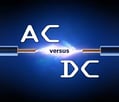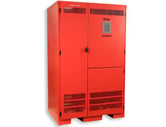During a storm or disaster, you may have experienced power outages. Your emergency lighting system should be ready if you experience a power outage from a small incident or a major catastrophe. Here is where an inverter comes in.
Why Do I Need an Emergency Lighting Inverter?
Inverters provide back-up for lighting during an emergency. This ensures lights stay on during a power outage and allows occupants to find the exits quickly should an evacuation occur.
Inverters also regulate voltage and prevent surges, keeping your lighting systems running well during normal times. Inverters are suitable across settings, from retail and commercial to hospitality and schools. Inverters ensure safe exit and continuation of operations.
How Inverters Work 
There are two types of electrical current. There is the continuous flow of electrons in one direction such as you find in batteries, and this is called direct current, or DC. On the other hand, there is the flow of electrons that changes direction and is called alternating current, or AC. Most electrical systems in businesses use alternating current in order to work. The emergency lighting inverter stays in standby mode when standard AC power is present. While in this mode, it charges the batteries.
When a building loses power, however, the emergency lighting may need to use a battery to continue operating while people use its light. An inverter is a device that has batteries which send their electricity into an oscillator circuit made of transistors and semi-conductors. The circuit flips on and off to cause the current to alternate, creating AC. That AC then goes to the emergency lights. If the inverter is for providing continuous power for all styles of lighting, it is sometimes called Uninterruptible Power Supply, or UPS.
What To Look For In An Inverter

The type of inverter you get will depend on your needs. The inverter has to have the same wattage as your emergency lights and the same voltage as the batteries in order to work. This should be listed on the inverter. The inverter should list the total wattage that you will be using at any one time so that it can power all the lights that have to be on. The inverter should meet the standards of UL924 and perform according to different codes including the NFPA 101, the NFPA 70, and the International Building Code. The inverter should be able to perform for 90 consecutive minutes at its annual test.
What Are the Different Types of Inverters?
The next thing to consider is your installation approach. An inverter can be put on a central power source to act as a backup for the entire building, and this is called a central lighting inverter. Central lighting inverters minimize maintenance requirements and enhance the performance of lighting. It is easier to maintain given it has one location and one battery system to test.
A business can also use dispersed lighting inverters by putting a battery and inverter in every light for which it wants to have a backup power source. Dispersed lighting is less expensive in up-front cost, but requires you to go to each light individually for functionality and battery testing.
How Often Should You Service Your Inverter? 
An emergency lighting system is required by law in many areas. To satisfy regulations and to ensure emergency lighting during an outage, you should service these systems twice a year. Maintenance of inverters includes checking the batteries, connections, and operation.
Getting good emergency lighting inverters can protect your employees, customers, and equipment. Here at Lighting Services, Inc. we can help you determine the type of emergency inverter that is best for you and your business, and we can install and service it. For more information, contact us.


